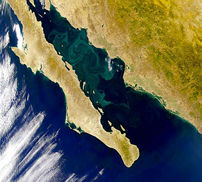Gulf of California LME
Introduction
The Gulf of California Large Marine Ecosystem (LME) is semi-enclosed and bordered by Baja California to the west and by mainland Mexico to the east. It was once known as the Sea of Cortez. The Gulf is long and narrow (1,500 km long by 175 km wide) and opens into the Pacific at its southern end, adjacent to the California Current LME. The southern part of the Gulf is over 200 m deep, and it includes the Guaymas trench, which is more than 3,600 m deep. The trench has volcanic and hydrothermal vents, and supports biotic communities based on hydrogen sulfide for energy, rather than sunlight. The northern part of the Gulf is shallower, due to the large amount of silt produced over the years by Colorado River run-off. Winds, tidal action and upwelling characterize the LME. It has mixed semi-diurnal tides and one of the greatest tidal ranges on earth. The tidal difference can correspond to up to 3 km of land and 9 m of vertical level in the northern part of the Gulf. The Gulf is highly productive for shrimp, small pelagics and giant squid and is the most important fishing region for Mexico. Industrial fisheries and coastal zone usage are driving forces of change; although formal evaluation of their effects has not yet been conducted.
Based on PICES. 2004. Marine Ecosystems of the North Pacific. PICES Special Publication Number 1, 280 pp
Based on PICES. 2004. Marine Ecosystems of the North Pacific. PICES Special Publication Number 1, 280 pp



